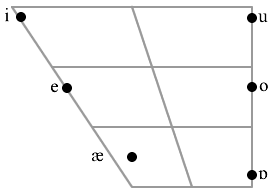משתמש:AlexKarpman/ארגז חול 1
כרגע בשימוש עבור כתיבת משתמש:AlexKarpman/אלפבית פרסי.
תנועות בפרסית[עריכת קוד מקור | עריכה]
סיכום של התנועות מפרסית לפני שני המקורות, ולאחר מכן איחוד:
ויקי האנגלית - w:en:Persian phonology[עריכת קוד מקור | עריכה]
Diachronically, Persian possessed a distinction of length in its underlying vowel inventory, contrasting the long vowels /i:/, /u:/, /ɒ:/ with the short vowels /e/, /o/, /æ/ respectively. In Modern Persian, this distinction of quantity is neutralized in most environments; short vowels lengthen in closed syllables. Because the neutralization is not complete and other processes, including a number of vowel quality alternations, depend on this distinction of length, it is not possible to analyze the underlying vowel inventory of Modern Persian without length. On the other hand, for reasons of concreteness, it is not desirable to analyze the short and long vowels as identical in quality (with their respective differences being derived by rule.)
Word-final /o/ does not occur frequently (except for to - 'thou'), and word-final /æ/ is very rare in Iranian Persian (except for næ - 'no'). The word-final /æ/ in Early New Persian mostly shifted to /e/ in contemporary Iranian Persian (often romanized as <eh>), but is preserved in the Eastern dialects.

| Phoneme | Sound (in IPA) | Letter | Romanization | Example(s) |
|---|---|---|---|---|
| /æ/ | [æ] | َ , ا | a | /næ/ نه no |
| /ɒ/ | [ɒ] | آ , ا | a, aa, ā, â, A | /tɒ/ تا till |
| /e/ | [e] | ِ , ا | e | /ke/ که that |
| /i/ | [i] | ی | i, ee, y | /ki/ کی who |
| /o/ | [o] | ا , ُ , و | o | /to/ تو thou |
| /u/ | [u] | و | u, oo, ou | /tu/ تو in |
| /ei/ | [ei] | ی | ey, ei, ay, ai | /kei/ کی when |
| /ou/ | [ou] | و | ow, au | /kou/ کو weevil |
אוניברסיטת מינסוטה - פרסית למתחילים[עריכת קוד מקור | עריכה]
The Nonconnectors[עריכת קוד מקור | עריכה]
| basic form |
| ا |
1. The Letter ا ælef
| basic form |
| و |
4. The letter vav
In a few instances such as in دو do (two), vav represents the vowel o. The words that use vav to represent the vowel o will have to be memorized.
Vocalization[עריכת קוד מקור | עריכה]
1. Madda (~). When added directly over the top of a syllable initial ælef, the madda represents a syllable initial a, thus: آ = a. Dictionaries explain the madda as a modified form of ا ælef itself. They say it is written in this way to avoid writing two ælefs (اا) to represent the initial vowel a. If the syllable is not a word-initial syllable, the madda may be dropped. The letter ælef alone represents the sound a in syllable-medial and syllable-final positions:
The Connectors[עריכת קוד מקור | עריכה]
Practice Reading[עריכת קוד מקור | עריכה]
